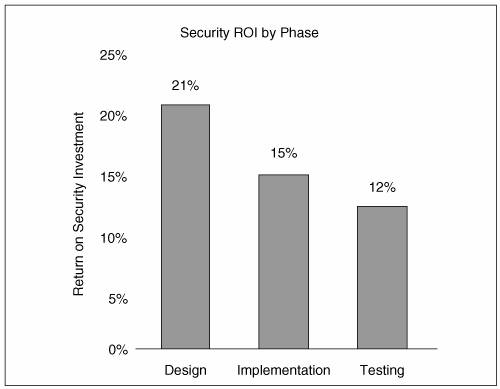The Importance of Measurement
| One foundational approach that is critical to any science is measurement. As Lord Kelvin put it:
Measurement is critical to the future of software security. Only by quantizing our approach and its impact can we answer questions such as: How secure is my software? Am I better off now than I was before? Am I making an impact on the problem? How can I estimate and transfer risk? We can begin to approach the measurement problem by recycling numbers from the software literature. For example, we know that fixing software problems at the design stage is much cheaper than fixing them later in the lifecycle.[7] An IBM study reports relative cost weightings as: design, 1; implementation, 6.5; testing, 15; maintenance, 100. We also know relative cost expenditures for lifecycle stages: design, 15%; implementation, 60%; testing, 25%. These and similar numbers can provide a foundation for measuring the impact of software security.
Measuring ReturnA preliminary study reported by @stake (now part of Symantec) demonstrates the importance of concentrating security analysis efforts at the design stage relative to the implementation and testing phases (see Figure 2-2). Microsoft reports that more than 50% of the software security problems it finds are design flaws. Figure 2-2. Return on investment (ROI) as measured by @stake over 23 security engagements.[8]
Risk management calls for quantitative decision support. Work remains to be done on measuring software security and software security risk, but some metrics are obvious. The most effective metrics involve tracking risk over time. Measurement and Metrics in the RMFThe most natural and easiest form of measurement in the RMF involves measuring and tracking information about risks and risk status at various times throughout application of the RMF. The Cigital Workbench (explained in the next section) helps to automate this activity. The fact that software development unfolds over time is a boon for measurement because a relative quantity (such as number of risks) measured at two different times can be used to indicate progress. Risk measurements include but are not limited to:
These kinds of measurements should be made as early as possible and as continuously as possible during the SDLC. |
EAN: 2147483647
Pages: 154
